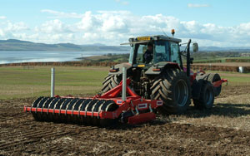
Field research at the Scottish Crop Research Institute's (SCRI) farm at Mylnefield, Invergowrie, is benefiting from the addition to its implement fleet of a SUMO Trio disc/press cultivator. The Trio will enable SCRI to assess the environmental impact of crop establishment methods, ranging from a full plough/cultivation regime to complete no-tillage.
The Trio is currently being used in a field experiment on a loamy sand site containing 15 trial plots. Assessment is taking place of five different ways of establishing combinable crops: ploughing at 20cm/8in; deep ploughing and pressing; ploughing and double pressing to simulate compaction; min-tillage using the Trio; and no-till.
SCRI farm manager, Euan Caldwell, explains that the same crop establishment practice is used on each respective plot for the entire duration of the trial (now in its third season) to assess the long-term impact of each.
"We began this SEERAD-funded trial three years ago in response to the way in which crop establishment on farms was changing towards min-till techniques," says Mr Caldwell.
"There is still a lot to be learned about the benefits and disadvantages of using minimum tillage in Scotland. Because of the wet conditions we can face here in the autumn compaction can be a big problem in preventing roots from establishing, though this can vary depending on the establishment method used. It tends to be a problem particularly associated with ploughing, and the creation of a pan below the ploughing depth."
In order to assess the impact of minimum tillage on soil compaction the SCRI farm purchased a 3m Sumo Trio cultivator last season, comprising of a row of low-draught subsoiler legs, a double row of 500mm concave discs and a purpose-designed SUMO Multipacka press.
"We needed a disc-type cultivator with subsoiling legs to fulfill the min-till part of our field research, and had a number of machines on demonstration. But I felt the Trio offered a number of benefits, being well-engineered, having plenty of weight to ensure the set depth stayed set, and possessing side discs that don't leave ridges. That latter feature is especially important when working with small plot drills. It's also easy to adjust: using pins rather than winders means the cultivator components can be easily re-set to the position used the previous year. Again, that's invaluable for field research where we need to use the same approach year after year."
The 3m Trio is operated behind a 120hp Massey Ferguson 6270, with a Sumo press on the tractor's front linkage which primarily acts as a counterweight. Both the Trio and the farm's four-furrow plough and press are also operated across the unit's commercial acreage, with the Trio also used to create a seedbed on over-wintered ploughed ground.
"Given that Scottish arable farmers are increasingly looking to min-till crop establishment methods as a way of cutting their cultivation costs, the crop and soil response being studied in this field experiment will be particularly relevant to many arable units," said Mr Caldwell. "The addition of the Trio to the farm fleet has enabled us to assess the compaction and environmental impacts of the complete range of crop establishment methods."
